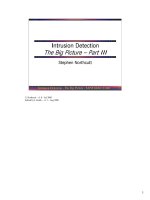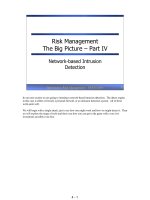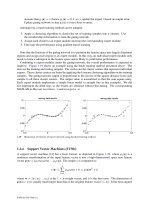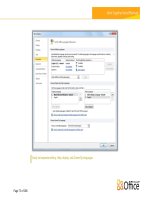Tài liệu Solution of Linear Algebraic Equations part 1 docx
Bạn đang xem bản rút gọn của tài liệu. Xem và tải ngay bản đầy đủ của tài liệu tại đây (81.69 KB, 5 trang )
Sample page from NUMERICAL RECIPES IN C: THE ART OF SCIENTIFIC COMPUTING (ISBN 0-521-43108-5)
Copyright (C) 1988-1992 by Cambridge University Press.Programs Copyright (C) 1988-1992 by Numerical Recipes Software.
Permission is granted for internet users to make one paper copy for their own personal use. Further reproduction, or any copying of machine-
readable files (including this one) to any servercomputer, is strictly prohibited. To order Numerical Recipes books,diskettes, or CDROMs
visit website or call 1-800-872-7423 (North America only),or send email to (outside North America).
Chapter 2. Solution of Linear
Algebraic Equations
2.0 Introduction
A set of linear algebraic equations looks like this:
a
11
x
1
+ a
12
x
2
+ a
13
x
3
+ ···+a
1N
x
N
=b
1
a
21
x
1
+ a
22
x
2
+ a
23
x
3
+ ···+a
2N
x
N
=b
2
a
31
x
1
+ a
32
x
2
+ a
33
x
3
+ ···+a
3N
x
N
=b
3
··· ···
a
M1
x
1
+a
M2
x
2
+a
M3
x
3
+···+a
MN
x
N
= b
M
(2.0.1)
Here the N unknowns x
j
, j =1,2,...,N are related by M equations. The
coefficients a
ij
with i =1,2,...,M and j =1,2,...,N are known numbers, as
are the right-hand side quantities b
i
, i =1,2,...,M.
Nonsingular versus Singular Sets of Equations
If N = M then there are as many equations as unknowns, and there is a good
chance of solving for a unique solution set of x
j
’s. Analytically, there can fail to
be a unique solution if one or more of the M equations is a linear combination of
the others, a condition called row degeneracy, or if all equations contain certain
variables only in exactly the same linear combination, called column degeneracy.
(For square matrices, a row degeneracy implies a column degeneracy, and vice
versa.) A set of equations that is degenerate is called singular. We will consider
singular matrices in some detail in §2.6.
Numerically, at least two additional things can go wrong:
• While not exact linear combinations of each other, some of the equations
may be so close to linearly dependent that roundoff errors in the machine
render them linearly dependent at some stage in the solution process. In
this case your numerical procedure will fail, and it can tell you that it
has failed.
32
2.0 Introduction
33
Sample page from NUMERICAL RECIPES IN C: THE ART OF SCIENTIFIC COMPUTING (ISBN 0-521-43108-5)
Copyright (C) 1988-1992 by Cambridge University Press.Programs Copyright (C) 1988-1992 by Numerical Recipes Software.
Permission is granted for internet users to make one paper copy for their own personal use. Further reproduction, or any copying of machine-
readable files (including this one) to any servercomputer, is strictly prohibited. To order Numerical Recipes books,diskettes, or CDROMs
visit website or call 1-800-872-7423 (North America only),or send email to (outside North America).
• Accumulated roundoff errors in the solution process can swamp the true
solution. This problem particularly emerges if N is too large. The
numerical procedure does not fail algorithmically. However, it returns a
set of x’s that are wrong, as can be discovered by direct substitution back
into theoriginalequations. Thecloser a set of equations is to being singular,
the more likely this is to happen, since increasingly close cancellations
will occur during the solution. In fact, the preceding item can be viewed
as the special case where the loss of significance is unfortunately total.
Much of the sophistication of complicated “linear equation-solving packages”
is devoted to the detection and/or correction of these two pathologies. As you
work with large linear sets of equations, you will develop a feeling for when such
sophistication is needed. It is difficult to give any firm guidelines, since there is no
such thing as a “typical” linear problem. But here is a rough idea: Linear sets with
N as large as 20 or 50 can be routinely solved in single precision (32 bit floating
representations) without resorting to sophisticated methods, if the equations are not
close to singular. With double precision (60 or 64 bits), this number can readily
be extended to N as large as several hundred, after which point the limiting factor
is generally machine time, not accuracy.
Even larger linear sets, N in the thousands or greater, can be solved when the
coefficients are sparse (that is, mostly zero), by methods that take advantage of the
sparseness. We discuss this further in §2.7.
At the other end of the spectrum, one seems just as often to encounter linear
problems which, by their underlying nature, are close to singular. In this case, you
might need to resort to sophisticated methods even for the case of N =10(though
rarely for N =5). Singular value decomposition (§2.6) is a technique that can
sometimes turn singular problems into nonsingular ones, in which case additional
sophistication becomes unnecessary.
Matrices
Equation (2.0.1) can be written in matrix form as
A · x = b (2.0.2)
Here the raised dot denotes matrix multiplication,A is the matrix of coefficients, and
b is the right-hand side written as a column vector,
A =
a
11
a
12
... a
1N
a
21
a
22
... a
2N
···
a
M1
a
M2
... a
MN
b =
b
1
b
2
···
b
M
(2.0.3)
By convention, the first index on an element a
ij
denotes its row, the second
index its column. For most purposes you don’t need to know how a matrix is stored
in a computer’s physical memory; you simply reference matrix elements by their
two-dimensional addresses, e.g., a
34
= a[3][4]. We have already seen, in §1.2,
that this C notation can in fact hide a rather subtle and versatile physical storage
scheme, “pointer to array of pointersto rows.” You might wish to review that section
34
Chapter 2. Solution of Linear Algebraic Equations
Sample page from NUMERICAL RECIPES IN C: THE ART OF SCIENTIFIC COMPUTING (ISBN 0-521-43108-5)
Copyright (C) 1988-1992 by Cambridge University Press.Programs Copyright (C) 1988-1992 by Numerical Recipes Software.
Permission is granted for internet users to make one paper copy for their own personal use. Further reproduction, or any copying of machine-
readable files (including this one) to any servercomputer, is strictly prohibited. To order Numerical Recipes books,diskettes, or CDROMs
visit website or call 1-800-872-7423 (North America only),or send email to (outside North America).
at this point. Occasionally it is useful to be able to peer through the veil,for example
to pass a whole row a[i][j], j=1,...,N by the reference a[i].
Tasks of Computational Linear Algebra
We will consider the following tasks as falling in the general purview of this
chapter:
• Solutionof the matrix equationA·x = b foran unknownvector x,whereA
is a square matrix of coefficients, raised dot denotes matrix multiplication,
and b is a known right-hand side vector (§2.1–§2.10).
• Solution of more than one matrix equation A · x
j
= b
j
, for a set of vectors
x
j
, j =1,2,..., each corresponding to a different, known right-handside
vector b
j
. In this task the key simplification is that the matrix A is held
constant, while the right-hand sides, the b’s, are changed (§2.1–§2.10).
• Calculation of the matrix A
−1
which is the matrix inverse of a square
matrix A, i.e., A · A
−1
= A
−1
· A = 1,where1is the identity matrix
(all zeros except for ones on the diagonal). This task is equivalent,
for an N × N matrix A, to the previous task with N different b
j
’s
(j =1,2,...,N), namely the unit vectors (b
j
= all zero elements except
for 1 in the jth component). The corresponding x’s are then the columns
of the matrix inverse of A (§2.1 and §2.3).
• Calculation of the determinant of a square matrix A (§2.3).
If M<N,orifM=Nbut the equations are degenerate, then there are
effectively fewer equations than unknowns. In this case there can be either no
solution, or else more than one solution vector x. In the latter event, the solution
space consists of a particular solution x
p
added to any linear combination of
(typically) N − M vectors (which are said to be in the nullspace of the matrix A).
The task of finding the solution space of A involves
• Singular value decomposition of a matrix A.
This subject is treated in §2.6.
In the opposite case there are more equations than unknowns, M>N.When
this occurs there is, in general, no solution vector x to equation (2.0.1), and the set
of equations is said to be overdetermined. It happens frequently, however, that the
best “compromise” solution is sought, the one that comes closest to satisfying all
equations simultaneously. If closeness is defined in the least-squares sense, i.e., that
the sum of the squares of the differences between the left- and right-hand sides of
equation (2.0.1) be minimized, then the overdetermined linear problem reduces to
a (usually) solvable linear problem, called the
• Linear least-squares problem.
Thereduced set of equationsto be solved can bewritten as the N ×N set of equations
(A
T
· A) · x =(A
T
·b)(2.0.4)
where A
T
denotes the transpose of the matrix A. Equations (2.0.4) are called the
normal equations of the linear least-squares problem. There is a close connection
2.0 Introduction
35
Sample page from NUMERICAL RECIPES IN C: THE ART OF SCIENTIFIC COMPUTING (ISBN 0-521-43108-5)
Copyright (C) 1988-1992 by Cambridge University Press.Programs Copyright (C) 1988-1992 by Numerical Recipes Software.
Permission is granted for internet users to make one paper copy for their own personal use. Further reproduction, or any copying of machine-
readable files (including this one) to any servercomputer, is strictly prohibited. To order Numerical Recipes books,diskettes, or CDROMs
visit website or call 1-800-872-7423 (North America only),or send email to (outside North America).
between singular value decomposition and the linear least-squares problem, and the
latter is also discussed in §2.6. You should be warned that direct solution of the
normal equations (2.0.4) is not generally the best way to find least-squares solutions.
Some other topics in this chapter include
• Iterative improvement of a solution (§2.5)
• Various special forms: symmetric positive-definite (§2.9), tridiagonal
(§2.4), band diagonal (§2.4), Toeplitz (§2.8), Vandermonde (§2.8), sparse
(§2.7)
• Strassen’s “fast matrix inversion” (§2.11).
Standard Subroutine Packages
We cannot hope, in this chapter or in this book, to tell you everything there is to
know about the tasks that have been defined above. In many cases you will have no
alternative but to use sophisticated black-box program packages. Several good ones
are available, thoughnot always in C. LINPACK was developed at Argonne National
Laboratories and deserves particular mention because it is published, documented,
and available for free use. A successor to LINPACK, LAPACK, is now becoming
available. Packages available commercially (though not necessarily in C) include
those in the IMSL and NAG libraries.
You should keep in mind that the sophisticated packages are designed with very
large linear systems in mind. They therefore go to great effort to minimize not only
the number of operations, but also the required storage. Routines for the various
tasks are usually provided in several versions, corresponding to several possible
simplifications in the form of the input coefficient matrix: symmetric, triangular,
banded, positive definite, etc. If you have a large matrix in one of these forms,
you should certainly take advantage of the increased efficiency provided by these
different routines, and not just use the form provided for general matrices.
There is also a great watershed dividing routines that are direct (i.e., execute
in a predictable number of operations) from routines that are iterative (i.e., attempt
to converge to the desired answer in however many steps are necessary). Iterative
methods become preferable when the battle against loss of significance is in danger
of being lost, either due to large N or because the problem is close to singular. We
will treat iterative methods only incompletely in this book, in §2.7 and in Chapters
18 and 19. These methods are important, but mostly beyond our scope. We will,
however, discuss in detail a technique which is on the borderline between direct
and iterative methods, namely the iterative improvement of a solution that has been
obtained by direct methods (§2.5).
CITED REFERENCES AND FURTHER READING:
Golub, G.H., and Van Loan, C.F. 1989,
Matrix Computations
, 2nd ed. (Baltimore: Johns Hopkins
University Press).
Gill, P.E., Murray, W., and Wright, M.H. 1991,
Numerical Linear Algebra and Optimization
,vol.1
(Redwood City, CA: Addison-Wesley).
Stoer, J., and Bulirsch, R. 1980,
Introduction to Numerical Analysis
(New York: Springer-Verlag),
Chapter 4.
Dongarra, J.J., et al. 1979,
LINPACK User’s Guide
(Philadelphia: S.I.A.M.).
36
Chapter 2. Solution of Linear Algebraic Equations
Sample page from NUMERICAL RECIPES IN C: THE ART OF SCIENTIFIC COMPUTING (ISBN 0-521-43108-5)
Copyright (C) 1988-1992 by Cambridge University Press.Programs Copyright (C) 1988-1992 by Numerical Recipes Software.
Permission is granted for internet users to make one paper copy for their own personal use. Further reproduction, or any copying of machine-
readable files (including this one) to any servercomputer, is strictly prohibited. To order Numerical Recipes books,diskettes, or CDROMs
visit website or call 1-800-872-7423 (North America only),or send email to (outside North America).
Coleman, T.F., and Van Loan, C.1988,
Handbook for Matrix Computations
(Philadelphia: S.I.A.M.).
Forsythe, G.E., and Moler, C.B. 1967,
Computer Solution of Linear Algebraic Systems
(Engle-
wood Cliffs, NJ: Prentice-Hall).
Wilkinson, J.H., and Reinsch, C. 1971,
Linear Algebra
,vol.IIof
Handbook for Automatic Com-
putation
(New York: Springer-Verlag).
Westlake, J.R. 1968,
A Handbook of Numerical Matrix Inversion and Solution of Linear Equations
(New York: Wiley).
Johnson, L.W., and Riess, R.D. 1982,
Numerical Analysis
, 2nd ed. (Reading, MA: Addison-
Wesley), Chapter 2.
Ralston, A., and Rabinowitz, P. 1978,
A First Course in Numerical Analysis
, 2nd ed. (New York:
McGraw-Hill), Chapter 9.
2.1 Gauss-Jordan Elimination
For inverting a matrix, Gauss-Jordan elimination is about as efficient as any
other method. For solving sets of linear equations, Gauss-Jordan elimination
produces both the solution of the equations for one or more right-hand side vectors
b, and also the matrix inverse A
−1
. However, its principal weaknesses are (i) that
it requires all the right-hand sides to be stored and manipulated at the same time,
and (ii) that when the inverse matrix is not desired, Gauss-Jordan is three times
slower than the best alternative technique for solving a single linear set (§2.3). The
method’s principal strength is that it is as stable as any other direct method, perhaps
even a bit more stable when full pivoting is used (see below).
If you come along later with an additional right-hand side vector, you can
multiplyit by the inverse matrix, of course. This does give an answer, but one that is
quite susceptible to roundoff error, not nearly as good as if the new vector had been
included with the set of right-hand side vectors in the first instance.
For these reasons, Gauss-Jordan elimination should usually not be your method
of first choice, either for solving linear equations or for matrix inversion. The
decomposition methods in §2.3 are better. Why do we give you Gauss-Jordan at all?
Because it is straightforward, understandable, solid as a rock, and an exceptionally
good “psychological” backup for those times that something is going wrong and you
think it might be your linear-equation solver.
Some people believe that the backup is more than psychological, that Gauss-
Jordan elimination is an “independent” numerical method. This turns out to be
mostly myth. Except for the relatively minor differences in pivoting, described
below, the actual sequence of operations performed in Gauss-Jordan elimination is
very closely related to that performed by the routines in the next two sections.
For clarity, andto avoidwritingendless ellipses(···) we will write out equations
only for the case of four equations and four unknowns, and with three different right-
hand side vectors that are known in advance. You can write bigger matrices and
extend the equations to the case of N × N matrices, with M sets of right-hand
side vectors, in completely analogous fashion. The routine implemented below
is, of course, general.









